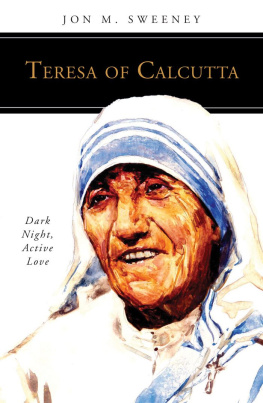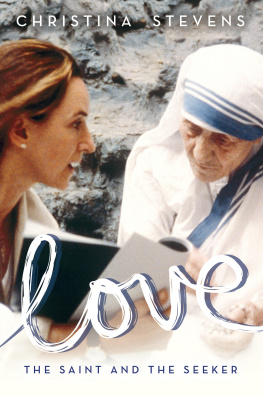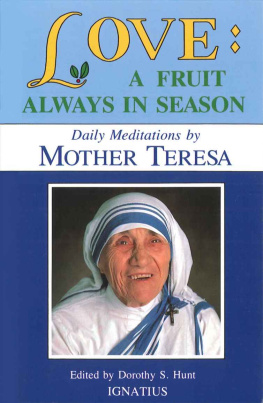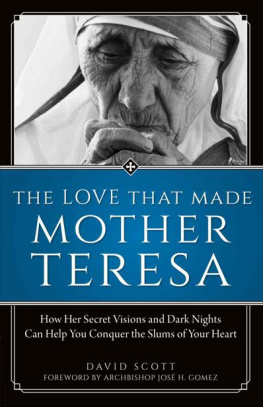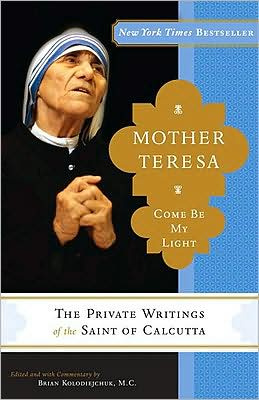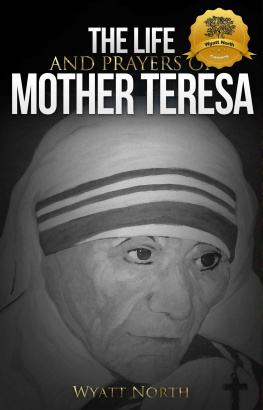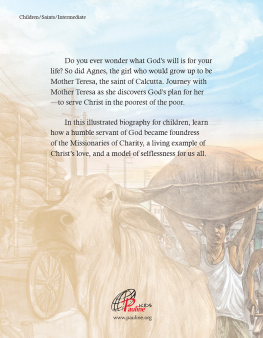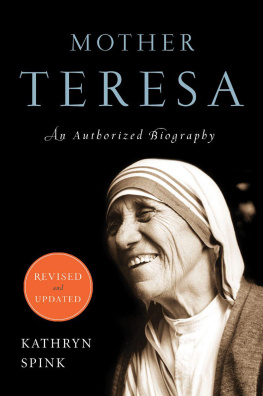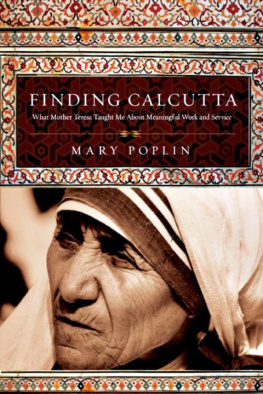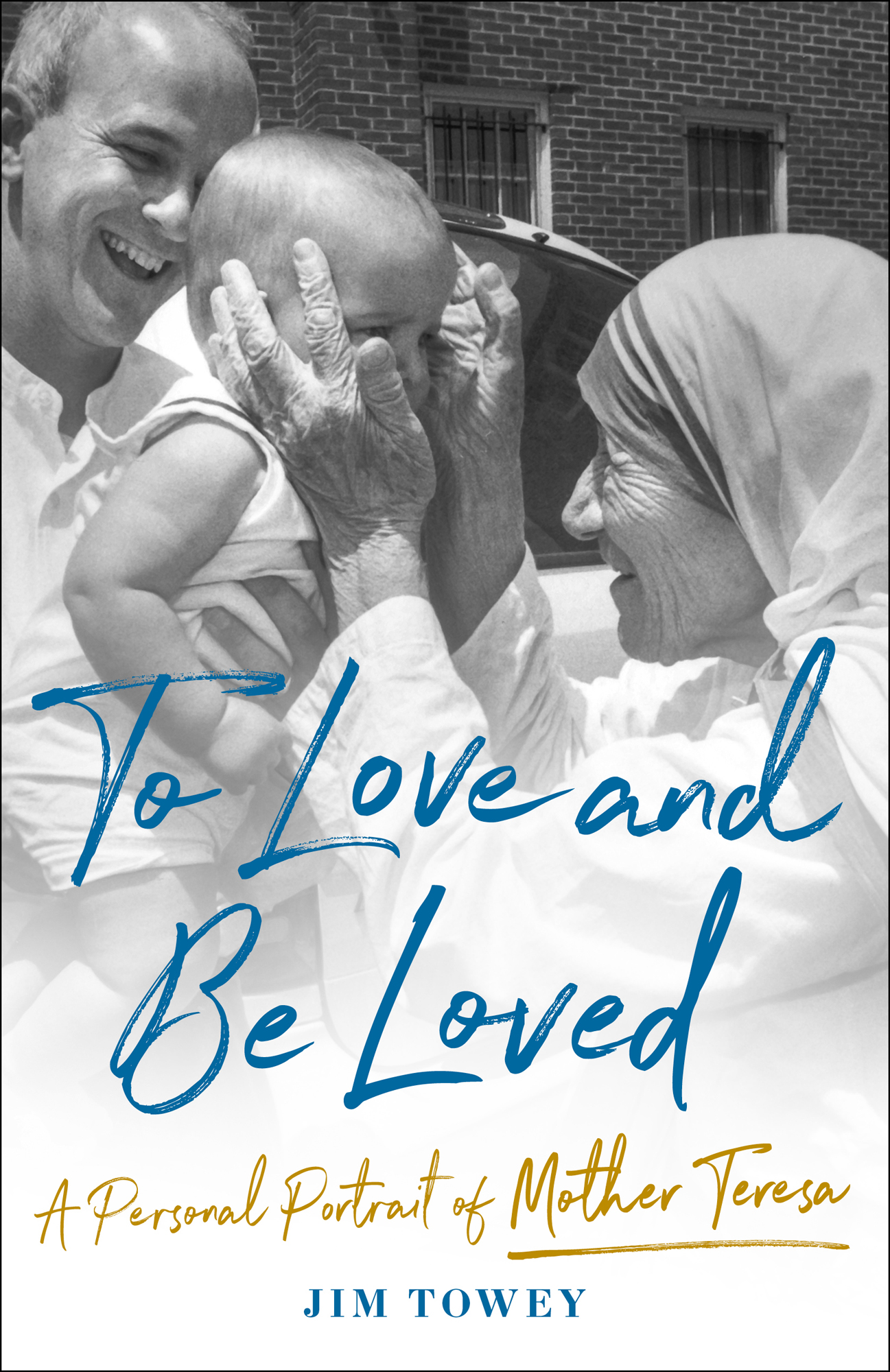|CONTENTS |
Guide
To Love and Be Loved
A Personal Portrait of Mother Teresa
Jim Towey
In honor of Mary, the Mother of God
Then the King will say to those on his right hand, Come, you whom my Father has blessed, take for your heritage the kingdom prepared for you since the foundation of the world. For I was hungry and you gave me food; I was thirsty and you gave me drink; I was a stranger and you made me welcome; naked and you clothed me, sick and you visited me, in prison and you came to see me. Then the virtuous will say to him in reply, Lord, when did we see you hungry and feed you; or thirsty and give you drink? When did we see you a stranger and make you welcome; naked and clothe you; sick or in prison and go to see you? And the King will answer, I tell you solemnly, in so far as you did this to one of the least of these brothers of mine, you did it to me.
Matthew 25:3440
|INTRODUCTION| The Mother I Knew
A life not lived for others is not worth living.
Mother Teresa
September 13, 1997
I t was 2 a.m. when I arrived at Saint Thomas Church in Calcutta on the day of Mother Teresas state funeral. I had landed hours earlier with the other members of the official U.S. delegation led by First Lady Hillary Clinton. My fellow delegates had gone off to catch up on sleep, though two sisters of the Missionaries of Charity who had flown with us went straight to the motherhouse to join the hundreds of their fellow MCs converging upon the city.
Queens, presidents, dignitaries, and celebrities from all over the world had come to attend the funeral, including the anchors of the three American television networks and CNN. (The same international press corps had covered Princess Dianas funeral a week earlier.) Every high-end hotel in the city was filled to capacity. The U.S. delegation was split between the two finestthe Oberoi and the Taj Bengalbut I had no interest in sleep. I wanted to get as near as possible to Mother.
Even at that early hour, there was a crowd milling about outside the 150-year-old church, and dozens of sisters were in quiet conversation near the entrance. Mother had lain in state here, draped in an Indian flag, for a week, and hundreds of thousands of well-wishers had filed past her body. She would ride to her final resting place on the same gun carriage that carried Mohandas Gandhis body in 1948. There were military personnel and city police at the ready, though the sisters were doing a fine job guarding Mother themselves. I entered the sanctuary of the church and saw a good number of them keeping vigil, and I joined them. There were few dry eyes in the sanctuary.
Mother Teresa looked remarkably well preserved. The team of embalmers from Bombay who had come to Calcutta immediately after her death could be proud. Their efforts were aided by six hastily installed air conditioners that fought bravely to counteract the punishing subtropical heat. Still, her face was somewhat ashen, and her hands and feet a little discolored. Her darker complexion made her look Indian. She was dressed in her trademark sari, and her rosarywhich in times past she would swap with mine when we prayed on a car tripstretched from her hands, resting on her stomach. Her body seemed sacred. On the night Mother died, Sister Gertrude had carefully withdrawn vials of blood from Mother to preserve it for reliquary. (I was later given a blood relic.) A sister had given me several medals when I first came to the foot of Mothers coffin. I took these medals, and my rosary, and touched them to her bare feet. Now, as I knelt before her body, I could grieve freely, and I did. These were not all tears of sadness. I was overcome with gratitude to God and to this woman who had given me so much joy.
Just as the Roman calendar is separated into eras before and after the birth of Christ, so my life can be fairly divided into two distinct periods: before and after Mother. Meeting her not only reshaped how I thought and acted, but ultimately determined every significant choice I made, from the jobs I have taken, to the woman I married, to the house we live in, to how I spend my days. I knew Mother during the last twelve years of her life, from 1985 until her death in 1997. I was her lawyer, and legal counsel for the Missionaries of Charity (work I continue to do), but more important, I was her friend, and Mother was mine. She guided me on matters big and small and allowed me to help her where I could. She showed me that everyday moments offer the greatest opportunity to serve God by doing small things with great love. It is no exaggeration to say that she taught me how to live and love.
So many memories rushed to mind as I knelt at Mothers feet in Saint Thomas Church. All the joys I had known with my wife and our children could be traced back to that fateful day in 1985 when Mother welcomed me in Calcutta and sent me to Kalighat, her Home for the Dying. She brought me to Jesusnot the concept of Jesus, not the historical figure of twenty centuries ago, but the living God whom I could access by faith.
I thought, too, of all the friends I had made because of her. Many of the people I cherished most I had only met because they were close to Mother: Sandy McMurtrie, for instance, and the filmmaker Jan Petrie. Naresh and Sunita Kumar, the Calcutta couple who were like family to Mother, had become family to me. I thought of the many MC sisters I had come to know and love over the years, as well as the MC fathers with whom I had lived in Tijuana and who were my brothers for life.
Most of all, though, I thought of the poorest of the poor, from the many dying men and women I came to know at the Gift of Peace AIDS home to the soup-kitchen regulars across town whom I befriended. Mother referred to the neediest as Jesus in His distressing disguise of the poorest of the poor. She based this belief on the actual presence of God in the person of the poor on the teaching of Jesus recorded in Matthews Gospel:
For I was hungry and you gave me food; I was thirsty and you gave me drink sick and you visited me. In so far as you did this to one of the least of these brothers of mine, you did it to me.
This passage was central to the mission of the Missionaries of Charity, and Mother made a point of working the words you did it to me into nearly every public or private talk I heard her give. Her faith told her she interacted with God whenever she helped the poor, which was why she distinguished the work she and her sisters did from social work. She once said in an interview, The work is only the expression of the love we have for God. We have to pour our love on someone. And the people are the means of expressing our love.
My relationships with the people the Missionaries of Charity served had Mother Teresas fingerprints on them. There was no chance I would ever have met them without Mothers invitation to touch Jesus in His distressing disguise, which, by degree, I slowly came to realize they were.
Memories of them constitute some of the most graphic proofs to me of the loving presence of God in the world, of the ocean of mercy that engulfs the willing and unwilling alike, and of the debt I owe Mother Teresa for changing the entire trajectory of my life. This realization descended upon me in waves of gratitude in Saint Thomas Church, but also sadness. She was gone for good, no longer a phone call or plane ride away.
As I prayed in the early hours of September 13, 1997, I was hounded by a simple question that had nagged me for some time: Why me? Why did I get to have this privileged relationship with Mother Teresa? I surely didnt deserve it. I know the sinner I was on the day I met her, and how I felt at Kalighat, helping a sick man not through any good purpose, but because I was too proud to admit to the sister in charge that I didnt want to touch him. I am still that same sinner. So why me? I didnt have an answer that night, but I do now.


